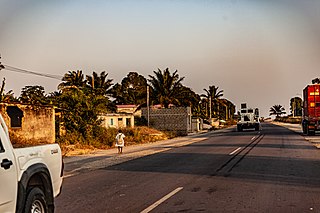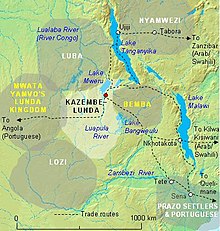
Zambia, officially the Republic of Zambia, is a landlocked country at the crossroads of Central, Southern and East Africa. It is typically referred to being in South-Central Africa or Southern Africa. It is bordered to the north by the Democratic Republic of the Congo, Tanzania to the north-east, Malawi to the east, Mozambique to the southeast, Zimbabwe and Botswana to the south, Namibia to the southwest, and Angola to the west. The capital city of Zambia is Lusaka, located in the south-central part of Zambia. The population is concentrated mainly around Lusaka in the south and the Copperbelt Province to the north, the core economic hubs of the country.
The history of Zambia experienced many stages from colonisation to independence from Britain on 24 October 1964. Northern Rhodesia became a British sphere of influence in the present-day region of Zambia in 1888, and was officially proclaimed a British protectorate in 1924. After many years of suggested mergers, Southern Rhodesia, Northern Rhodesia, and Nyasaland were merged into the British Federation of Rhodesia and Nyasaland.

Northern Province is one of Zambia's ten provinces. It covers approximately one-sixth of Zambia in land area. The provincial capital is Kasama. The province is made up of 12 districts, namely Kasama District, Chilubi District, Kaputa District, Luwingu District, Mbala District, Mporokoso District, Mpulungu District, Mungwi District, Nsama District, Lupososhi District, Lunte District and Senga Hill District. Currently, only Kasama and Mbala have attained municipal council status, while the rest are still district councils. It is widely considered to be the heartland of the Bemba, one of the largest tribes in Zambia.
The Nsenga, not to be confused with the Senga, are a Bantu ethnic tribe of Zambia and Mozambique. In Zambia, they are found in two districts of Eastern province namely Nyimba and Petauke. They are also dialects with the Nsenga Luzi of the Luangwa valley in Chief Nyalugwe, Mboloma and Lwembe and the Chikunda of Luangwa Boma (Feira). Their Senior Chief is Kalindawalo M'ndikula, who resides in Merwe 10 kilometers from Petauke Boma. The following are Nsenga Chiefs: Chiefs Mwape, Nyamphande, Nyanje, Mumbi, Sandwe, Nyalugwe, Ndake, Senior Chief Lwembe, Senior Chief Mboloma and Mwanjaw'anthu. They are well known for their culture and artwork which includes bead work and basketry. They also grow groundnuts, maize, millet and sorghum for consumption and cotton (Thonje) as cash crop, and are popular for their Mbewa (Mice), a practice which they are often teased for. The Nsenga language spoken by people of this tribe has been adopted by many groups in Zambia and diluted to Zambia’s widely spoken language Chinyanja or Nyanja.

The Kingdom of Kongo was a kingdom in Central Africa. It was located in present-day northern Angola, the western portion of the Democratic Republic of the Congo, Southern of Gabon and the Republic of the Congo. At its greatest extent it reached from the Atlantic Ocean in the west to the Kwango River in the east, and from the Congo River in the north to the Kwanza River in the south. The kingdom consisted of several core provinces ruled by the Manikongo, the Portuguese version of the Kongo title Mwene Kongo, meaning "lord or ruler of the Kongo kingdom", but its sphere of influence extended to neighboring kingdoms, such as Ngoyo, Kakongo, Loango, Ndongo, and Matamba, the latter two located in what is Angola today.

The Chewa are a Bantu ethnic group found in Malawi, Zambia and few in Mozambique. The Chewa are closely related to people in surrounding regions such as the Tumbuka and Nsenga. They are historically also related to the Bemba, with whom they share a similar origin in the Democratic Republic of the Congo. As with the Nsenga and Tumbuka, a small part of Chewa territory came under the influence of the Ngoni, who were of Zulu or Natal/Transvaal origin. An alternative name, often used interchangeably with Chewa, is Nyanja. Their language is called Chichewa. Internationally, the Chewa are mainly known for their masks and their secret societies, called Nyau, as well as their agricultural techniques.

Soyo is a city, with a population of 200,920, and a municipality, with a population of 227,175, located in the province of Zaire in Angola, at the mouth of the Congo river. Historically, Soyo was a significant city in conflicts between the Kingdom of Kongo, Portuguese Angola, and the Dutch West India Company. Soyo became an independent state in the 17th century and had significant influence on politics in Kongo during the Kongo Civil War.

Luapula Province is one of Zambia's ten provinces located in the northern part of the country. Luapula Province is named after the Luapula River and its capital is Mansa. As per the 2022 Zambian census, the Province had a population of 1,519,478, which accounted for 7.72 per cent of the total Zambian population.

Kazembe is a traditional kingdom in modern-day Zambia, and southeastern Congo. For more than 250 years, Kazembe has been an influential kingdom of the Kiluba-Chibemba, speaking the language of the Eastern Luba-Lunda people of south-central Africa. Its position on trade routes in a well-watered, relatively fertile and well-populated area of forestry, fishery and agricultural resources drew expeditions by traders and explorers who called it variously Kasembe, Cazembe and Casembe.
Nsundi was a province of the old Kingdom of Kongo. Its capital was located on the Inkisi River, near the present-day village of Mbanza Nsundi in Democratic Republic of Congo.
The Mambwe are an ethnic group from Mbala and Senga Hill district of Northeastern Zambia and Kalambo District of Rukwa Region, Tanzania. In 1987 the Mambwe population in Tanzania was estimated to number 63,000. The number of Mambwe in Zambia has not been independently estimated, though the combined number of Mambwe and Lungu people in Zambia was estimated to be 262,800 in 1993.
The Lungu are a tribe of two Bantu ethnic groups i.e. the Lungu of Chief Tafuna (Mambwe-Lungu) and the Lungu of Chief Mukupa Kaoma (Malaila-Lungu). The Mambwe Lungu, who are the main focus of this article are located primarily on the southwestern shores of Lake Tanganyika in Rukwa Region's Kalambo District, Tanzania and northeastern Zambia mainly in Mpulungu and Mbala district. In 1987 the Lungu population in Tanzania was estimated to number 34,000. The number of Lungu in Zambia has not been independently estimated, though the combined number of Mambwe and Lungu in Zambia was estimated to be 262,800 in 1993.

The Nation of Lunda was a confederation of states in what is now the Democratic Republic of Congo, north-eastern Angola, and north-western Zambia. Its central state was in Katanga.

Mvemba a Nzinga, Nzinga Mbemba, Funsu Nzinga Mvemba or Dom Alfonso, also known as King Afonso I, was the sixth ruler of the Kingdom of Kongo from the Lukeni kanda dynasty and ruled in the first half of the 16th century. He reigned over the Kongo Empire from 1509 to late 1542 or 1543.
Kazembe is a name used for Mwata Kazembe's town in the Luapula Province of Zambia, especially on maps and in the Zambian postal service. The other name for the town is Mwansabombwe and this is the one used by its or Luba or Chibemba-speaking inhabitants. They may refer in English to "Kazembe's Village" or just "Kazembe", as traditionally a settlement is named after the chief or headman, rather than the location. The Luba-Lunda shared with many tribes the custom of moving to another village or a new site on the death of the chief. Historical references to a village or town may actually be to a different location. For instance when the explorer David Livingstone visited Mwata Kazembe in 1867 and 1868, "Casembe's town", as he wrote it, was further north at the town now called Kanyembo.
The Chitimukulu is the King or Paramount Chief of the Bemba, the largest ethnic group in Zambia. All Chitimukulus, as well as lesser Bemba chiefs, are members of the Bena Ng'andu. Potential successors to the ruling Chikimukulu are chosen from the various Bemba chiefs.

The following outline is provided as an overview of and topical guide to Zambia:

The Bwile people are an ethnic group that live in the Democratic Republic of the Congo (DRC) and Zambia around the northern part of Lake Mweru.
The Basimba are a Bantu-speaking community in Uganda. The name Basimba is a label of shared identity that predates the 13th century. Basimba has been alternatively associated with the people or their place of origin. The early Ovambo people applied the name to the whole group of the leopard totem clan, known as Bena Ngo in Zambia and Abe Ngo in Uganda.
Leonor Nzinga Nlaza, was a queen consort of King Nzinga a Nkuwu of the Kingdom of Kongo.












